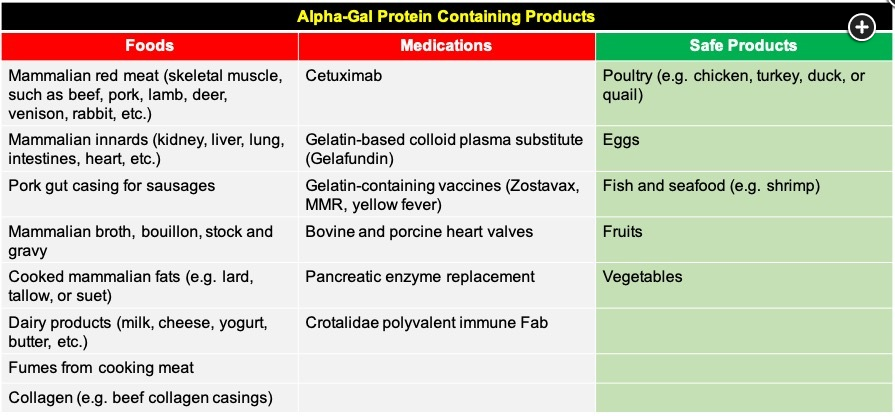red meat allergy
- related: Tick-Borne Diseases, tick born infections
- tags: #literature #pulmonology
The most likely diagnosis in this patient with anaphylaxis is an alpha-gal syndrome (AGS), also called allergy to red meat, or tick bite meat allergy (choice B is correct). AGS is a more recently described food allergy reported in different parts of the world and is associated with tick bites. It is a serious, potentially life-threatening allergic reaction, and it is not caused by an infection.
The alpha-gal epitope (galactose-alpha-1,3-galactose), an oligosaccharide, is the prime culprit responsible for AGS. The exact mechanism of how a tick bite causes human sensitization against alpha-gal and leads to the development of AGS is poorly understood. The presence of the alpha-gal epitope in tick species has been confirmed. AGS symptoms occur after people eat red meat or are exposed to products containing alpha-gal. The symptoms commonly appear 2 to 6 h after eating meat or dairy products or after exposure to products containing alpha-gal (for example, gelatin-coated medications). AGS reactions can be different from person to person. The symptoms can range from mild to severe or even life-threatening. The most common symptoms include hives or pruritic rash; nausea or vomiting; heartburn or indigestion; diarrhea; cough; shortness of breath; hypotension; lip, throat, tongue, or eyelid edema; dizziness or faintness; and severe abdominal pain. The most common food products that contain alpha-gal include mammalian meat (such as beef, pork, lamb, venison, or rabbit) and milk products, especially cow’s milk, which typically contains alpha-gal and is classified as a major food allergy. People with AGS may also be sensitive to alpha-gal found in gelatin made from beef or pork, cooked mammalian fats (such as lard, tallow, or suet), meat broth, bouillon, stock, and gravy. Foods that do not contain alpha-gal include poultry (chicken, turkey, duck, or quail), eggs, fish and seafood (eg, shrimp), fruits, and vegetables (choices A, C, and D are incorrect) (Figure 1).
Other nonfood products that may contain alpha-gal include some medications and vaccines with specific additives such as gelatin, glycerin, magnesium stearate, and bovine extract. Medical products, such as heart valves from pigs or cows, monoclonal antibodies, heparin, and certain antivenoms are animal derived and may contain alpha-gal. The diagnosis is challenging because there is inconsistency about the alpha-gal-specific IgE levels. In the United States alone, the number of confirmed cases of AGS has risen from only 12 in 2009 to 34,000 in 2019. It is predicted that the percentage of individuals living in endemic tick areas who have been sensitized to alpha-gal ranges from 15% to 30%. Furthermore, this syndrome is the leading cause of the onset of allergy and anaphylaxis in adults in the United States and is prevalent in the southeastern United States.
This emerging tick bite-induced food allergy has been reported to occur in 17 nations worldwide. Tick bites were first implicated in AGS in Australia, which is among the countries with the highest AGS and anaphylaxis rates in the world. Results of a surveillance study by the Centers for Disease Control and Prevention from 2012 to 2013 showed significantly higher alpha-gal-directed IgE levels in the areas inhabited by the lone star tick (Amblyomma americanum) population in the southeastern United States. Lone star ticks are easily identifiable by the trademark white dot found on the dorsal shield of the adult females. Adult male and female ticks are both reddish brown and round and have prominent festoons. Similarly, other ticks from the Amblyomma and Ixodes species have been reported in other parts of the world. Therefore, the treatment and prevention in patients with AGS include informing them that further tick bites can maintain or lead to increases in the titer of alpha-gal IgE levels. By contrast, most patients (close to 90%) who successfully avoid tick bites will experience a decrease in their alpha-gal IgE levels. The primary advice for patients with newly diagnosed AGS is to avoid completely the meat or internal organs of mammals, such as beef, pork, venison, and lamb. Avoidance of dairy and other food and medical products that contain alpha-gal is recommended. The treatment of AGS in the acute phase should follow the anaphylaxis treatment guidelines that include rapid administration of epinephrine as the first-line therapy, followed by β2-agonists such as albuterol, antihistamines (histamine-1 and histamine-2 receptor antagonists), and corticosteroids.1
